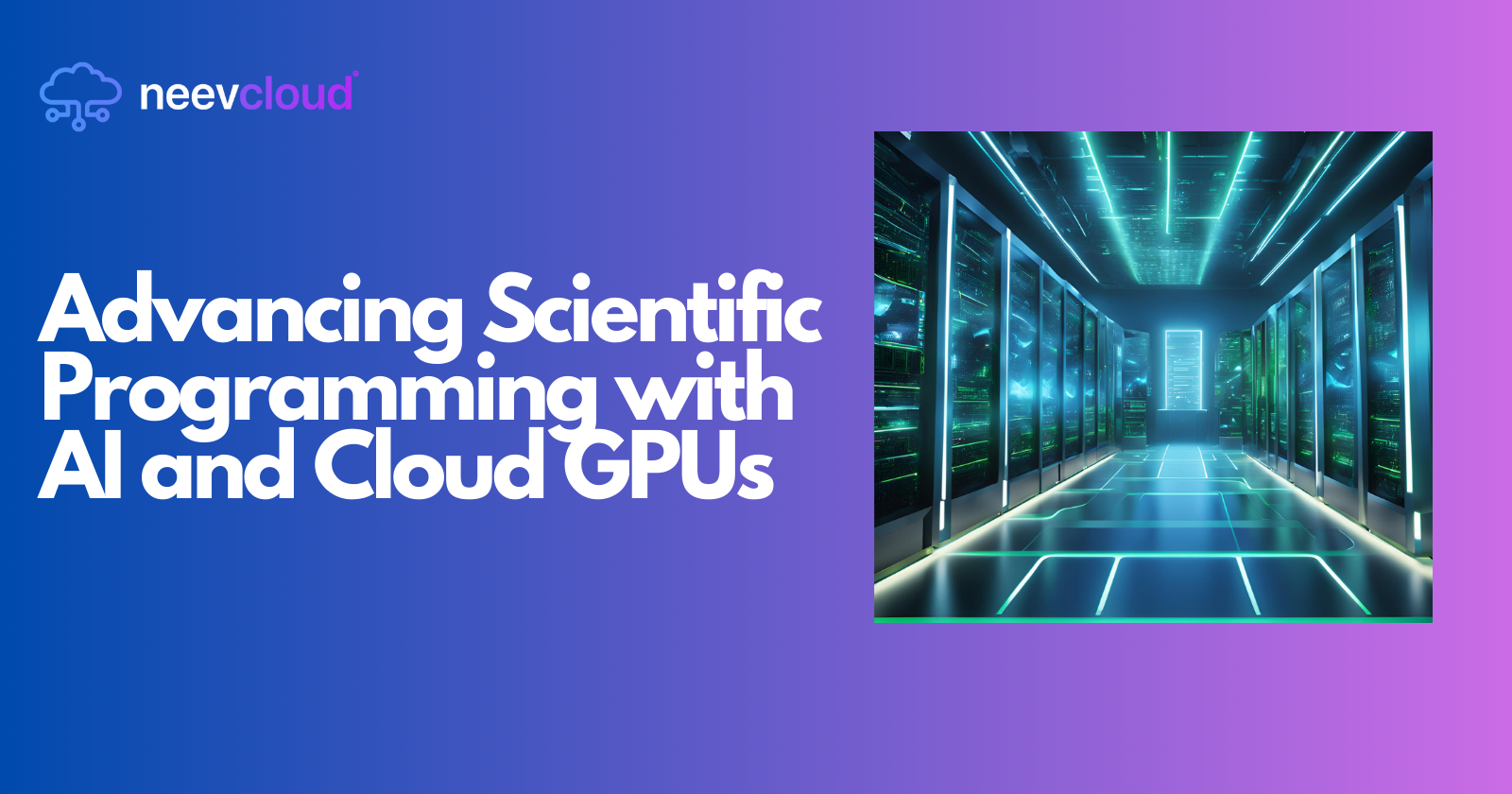Advancing Scientific Programming with AI and Cloud GPUs
 Tanvi Ausare
Tanvi Ausare
Scientific programming has been revolutionized by the emergence of data science, artificial intelligence (AI), and machine learning (ML), marking a shift toward optimized and scalable computational processes. In particular, the synergy of AI and data science on cloud platforms, such as NeevCloud's AI Cloud and Cloud GPU resources, has provided robust solutions for scientific programming, from high-level research to large-scale simulations. In this article, we explore how data science and AI-based advancements in scientific programming are driving innovation, enabling new research frontiers, and pushing the boundaries of computational possibilities.
The Role of AI in Scientific Programming
Artificial intelligence and machine learning have opened unprecedented opportunities in scientific programming, with applications across numerous disciplines, including physics, chemistry, biology, and engineering. The value AI brings to scientific programming can be attributed to several key advancements:
Automation of Complex Computations: AI algorithms automate data analysis, reducing human effort and enabling scientists to focus on interpreting results.
Improved Precision and Accuracy: Machine learning models, particularly those using deep learning, improve accuracy in simulations and predictions.
Enhanced Computational Efficiency: The adoption of optimized models speeds up complex calculations, crucial in fields like genomics, climate modeling, and astrophysics.
Key Challenges in Scientific Programming
Despite its advantages, scientific programming faces several challenges, which AI and cloud technologies aim to address:
Data Processing Complexity: Scientific data is often large, complex, and diverse, requiring efficient processing mechanisms.
High Computational Demand: Scientific applications, such as simulations and big data analytics, require high computational power.
Scalability and Flexibility: Scaling computational resources is challenging, particularly when dealing with fluctuating workloads.
AI Cloud: A New Era for Scientific Programming
NeevCloud's AI Cloud provides a centralized, scalable, and robust platform for scientific programming. Its impact on scientific programming is significant, given its AI, ML, and cloud GPU capabilities. Here’s how AI Cloud drives advancement in scientific programming:
Dynamic Resource Allocation: AI Cloud automatically adjusts resources based on computational requirements, saving time and reducing costs.
Efficient Data Management: AI Cloud manages large datasets with ease, supporting data-intensive scientific applications.
Real-Time Collaboration: Multiple researchers can work on a single AI Cloud instance, promoting real-time collaboration across geographic locations.
Access to Specialized AI Tools: AI Cloud platforms provide access to pre-built AI and ML models, streamlining the scientific research process.
Leveraging AI Datacenter for Scientific Advancements
AI Datacenters, like those offered by NeevCloud, represent specialized environments optimized for AI workloads. They provide scientific researchers with a flexible, high-performance infrastructure to run complex experiments and simulations.
Advantages of AI Datacenters in Scientific Programming:
High-Performance Computing (HPC) Integration: AI Datacenters offer computational power previously accessible only through supercomputing, now available for data scientists.
Scalable Infrastructure: Resources can be scaled up or down as needed, making AI Datacenters an ideal solution for projects of varying sizes.
Cost Efficiency: By centralizing resources, AI Datacenters reduce the need for individual research institutions to maintain expensive hardware.
Cloud GPU: Accelerating AI and Scientific Research
Cloud GPU services have emerged as essential tools for scientific research, accelerating AI, ML, and data science workloads in scientific programming. They reduce computation time from hours to seconds, fostering faster insights and enabling more complex models.
Benefits of Cloud GPU for Scientific Programming:
Massive Parallelism: GPUs can perform multiple operations simultaneously, an essential feature for large scientific datasets.
Reduced Latency: By processing data in the cloud, scientists can achieve near-instantaneous computation speeds.
Economical Scaling: Users only pay for the resources they need, reducing the cost of experimentation and exploration.
Faster Model Training: GPUs drastically cut down model training time, allowing scientists to iterate and refine models more quickly.
AI and ML in Scientific Programming: Practical Applications
Machine learning and AI algorithms are transforming how scientific programming is approached, with real-world applications reshaping diverse fields:
Genomics and Bioinformatics: AI models analyze DNA sequences, identifying gene patterns and accelerating drug discovery processes.
Climate Science: AI algorithms predict climate patterns, assisting in understanding and mitigating climate change effects.
Astrophysics: Machine learning models analyze vast datasets from telescopes, discovering new celestial objects.
Material Science: AI assists in developing new materials with specific properties, useful in fields like energy storage.
Key Benefits of Integrating AI, ML, and Cloud GPU in Scientific Programming
Scientific programming can be optimally advanced by leveraging AI, ML, and cloud GPU capabilities, enhancing the ability to process data, analyze results, and simulate real-world scenarios at unprecedented scales.
Specific Benefits Include:
Enhanced Data Analysis: AI models efficiently analyze large datasets, uncovering patterns and insights.
Automated Feature Engineering: Machine learning automates feature extraction, reducing time spent on data preprocessing.
Predictive Modeling: AI provides predictive insights, helping researchers hypothesize and validate scientific theories.
Reduction in Computational Time: Cloud GPUs speed up model training, enabling faster iteration.
Implementing Cost-Efficient Scientific Programming with AI Cloud
Managing costs is essential in scientific programming, particularly for academic and research institutions. AI Cloud solutions provide cost-efficient access to high-performance resources:
Optimal Resource Utilization: AI Cloud platforms dynamically allocate resources based on workload, minimizing wastage.
Reduced Infrastructure Investment: By leveraging the cloud, organizations avoid upfront costs of infrastructure and maintenance.
Optimizing Scientific Programming Workflows with AI Datacenters
AI Datacenters are designed to optimize scientific workflows, particularly in data-heavy fields that require rapid data processing and analysis.
Workflow Automation: AI Datacenters provide automation tools, allowing for streamlined, continuous data analysis.
Integration with DevOps: AI Datacenters support integration with DevOps workflows, facilitating faster development cycles.
Enhanced Data Security: Advanced security protocols ensure that sensitive scientific data is protected from unauthorized access.
AI and ML Tools for Scientific Programming on AI Cloud
On NeevCloud, AI and ML tools are accessible directly through the cloud, making it easier for scientific researchers to deploy and scale models.
Popular AI Tools Available on NeevCloud:
TensorFlow and PyTorch: Widely used deep learning frameworks, ideal for building custom scientific models.
Apache Spark: Optimized for big data analysis, providing distributed processing capabilities.
Jupyter Notebooks: Allows for interactive scientific programming, with easy integration of code, data, and visualization.
AutoML Tools: Simplifies the process of building and deploying machine learning models.
Key Features of NeevCloud for Scientific Programming
NeevCloud offers several unique features that empower scientific programming with AI and ML:
Customizable Cloud Infrastructure: Researchers can configure infrastructure to meet specific computational requirements.
User-Friendly Interface: NeevCloud’s dashboard simplifies resource management, deployment, and monitoring.
Collaboration Features: Built-in collaboration tools allow teams to work seamlessly across projects.
Real-Time Data Processing: NeevCloud supports real-time data processing, essential for time-sensitive scientific applications.
Real-World Case Studies: AI Cloud Transforming Scientific Programming
Case Study 1: Climate Modeling
Challenge: Traditional climate models took weeks to process data.
Solution: NeevCloud’s AI Cloud and Cloud GPU resources were used to accelerate model training, reducing computation time significantly.
Outcome: Enabled faster data processing, providing timely insights into climate change patterns.
Case Study 2: Genomic Research
Challenge: Identifying genetic markers in large genomic datasets is computationally expensive.
Solution: By utilizing AI Datacenter resources, genomic researchers reduced data analysis time by leveraging deep learning algorithms.
Outcome: New genetic markers were identified faster, aiding in drug discovery.
Future Trends in AI, ML, and Cloud GPU for Scientific Programming
As the capabilities of AI, ML, and Cloud GPU expand, the future of scientific programming appears promising. Emerging trends include:
Quantum AI Integration: Combining quantum computing with AI for exponentially faster data processing.
Advanced AI Model Interpretability: Enhanced model transparency, allowing researchers to better understand AI-driven insights.
Edge AI for Remote Data Collection: Using edge devices to collect and preprocess data in real time, ideal for field research.
Improved Data Privacy Mechanisms: Advanced encryption and anonymization techniques to protect sensitive scientific data on the cloud.
Conclusion
Data science and AI-based advancements are transforming scientific programming, bringing innovative solutions to previously complex challenges. By utilizing platforms like NeevCloud’s AI Cloud, AI Datacenter, and Cloud GPU services, researchers can access scalable, high-performance computational resources tailored to scientific workloads. These advancements not only enhance research accuracy and efficiency but also facilitate collaboration and knowledge sharing across disciplines.
In the future, the integration of AI, ML, and Cloud GPU into scientific programming will continue to redefine what is possible, empowering researchers to uncover insights faster and drive advancements in fields that impact our daily lives.
Subscribe to my newsletter
Read articles from Tanvi Ausare directly inside your inbox. Subscribe to the newsletter, and don't miss out.
Written by
